
James Wood-Mason was an English zoologist. He was the director of the Indian Museum at Calcutta, after John Anderson. He collected marine animals and lepidoptera, but is best known for his work on two other groups of insects, phasmids and mantises.

William Lucas Distant was an English entomologist.

Enrico Adelelmo Brunetti was a British musician and entomologist. He specialized in the Diptera and worked for many years in India.

Gaeanini is a tribe of cicadas in the family Cicadidae, found in the Palearctic and Indomalaya. There are about 10 genera and at least 50 described species in Gaeanini.
Tibiceninae is a historical subfamily name from the insect family Cicadidae. It was first used by Distant (1889). As of 2021, the name became unavailable to zoological nomenclature due to the suppression of its type genus Tibicen Berthold, 1827 by the International Commission on Zoological Nomenclature. Cicada genera grouped at the subfamily level with genus Lyristes are generally referenced under the name Cicadinae Latreille, 1802.

Drupadia is a butterfly genus in the family Lycaenidae. They are commonly known as posies. The members (species) of this genus are found in the Indomalayan realm.
Tibicenini is a historical tribe name from the insect family Cicadidae, based on the family group taxon established by Distant (1889). As of 2021, the name became unavailable to zoological nomenclature due to the suppression of its type genus Tibicen Berthold, 1827 by the International Commission on Zoological Nomenclature. Cicada genera grouped at the tribe level with genus Lyristes are generally referenced under the name Cryptotympanini Handlirsch, 1925.
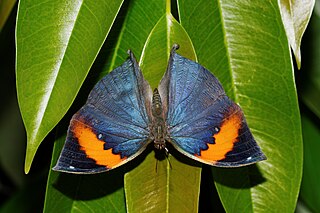
Kallima paralekta, the Indian leafwing or Malayan leafwing, is a species of brush-footed butterfly of the genus Kallima. Despite its common names, it is not found in India or Malaysia, but is endemic to Java and Sumatra of Indonesia. Like other members of its genus, it is remarkable for its strong resemblance to a dead leaf when its wings are folded. It was one of the species encountered by the British naturalist Alfred Russel Wallace in his travels in maritime Southeast Asia. It is mentioned in his famous 19th-century work The Malay Archipelago as one of the best examples of protective camouflage achieved through natural selection.

Gaeana is a genus of cicadas, most members of which have colourful marking on their forewings, found across tropical and temperate Asia. Their bright wing patterns have been hypothesized as being a case of Batesian mimicry where the toxic models may be day-flying moths of the subfamilies Zygaeninae and Arctiinae. It is closely related to the genus Tosena but is differentiated by the exposed tympanum and lacks spines on the sides of the pronotum.
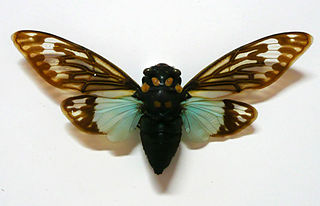
Distantalna splendida is a cicada species from Southeast Asia, and the sole member of the genus Distantalna. It was previously placed in the genus Tosena. A characteristic that distinguishes Distantalna splendida from the Tosena species is the partly pale hyaline tegmina and wings. The species of Tosena do not have hyaline parts in the tegmina and wings. It has been recorded from India, Myanmar and Thailand.

Tosena albata is a cicada species from Southeast Asia. It was described by William Lucas Distant in 1878 who, however, subsequently regarded it as a variety of Tosena melanoptera. However, in 2000 Boulard confirmed the species status of Tosena albata by comparing its song with that of other Tosena species. T. albata has hitherto been recorded from Thailand, Nepal, North India, and Northwestern Himalaya

Tosena mearesiana is a cicada species from Southeast Asia. It was described in 1842 by Westwood from a specimen originating from the Himalayas. It has also been recorded from Sikkim in India.
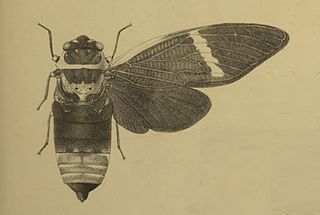
Formotosena montivaga is a cicada species from Southeast Asia that was formerly placed in the genus Tosena. It was described in 1889 by Distant from material collected in the Naga Hills which are on the border of India and Burma.
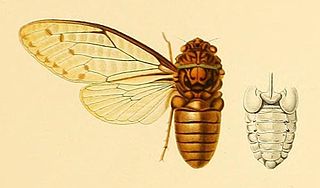
Leptopsaltria is a genus of cicadas from Southeast Asia and typical of the tribe Leptopsaltriini.
Pacarina is a genus of cicadas in the family Cicadidae. There are at least four described species in Pacarina.
Okanagana is a genus of cicadas in the family Cicadidae. There are at 58 described species in Okanagana.

Cacama is a genus of cicadas in the family Cicadidae commonly known as cactus dodgers. There are about 12 described species in Cacama.

Champaka is a genus of cicadas in the family Cicadidae. There are about 12 described species in Champaka.

Dundubia is a genus of cicadas in the subfamily Cicadinae and the type genus of the tribe Dundubiini.
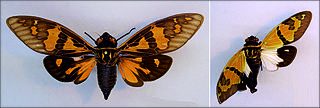
Callogaeana is a genus of Asian cicadas in the tribe Gaeanini. This genus includes species that were previously placed in Gaeana and sometimes known as known as "butterfly cicadas" due to their colourful wings.

















